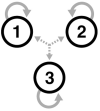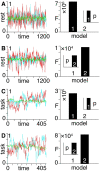Establishing brain states in neuroimaging data
- PMID: 37844124
- PMCID: PMC10602380
- DOI: 10.1371/journal.pcbi.1011571
Establishing brain states in neuroimaging data
Abstract
The definition of a brain state remains elusive, with varying interpretations across different sub-fields of neuroscience-from the level of wakefulness in anaesthesia, to activity of individual neurons, voltage in EEG, and blood flow in fMRI. This lack of consensus presents a significant challenge to the development of accurate models of neural dynamics. However, at the foundation of dynamical systems theory lies a definition of what constitutes the 'state' of a system-i.e., a specification of the system's future. Here, we propose to adopt this definition to establish brain states in neuroimaging timeseries by applying Dynamic Causal Modelling (DCM) to low-dimensional embedding of resting and task condition fMRI data. We find that ~90% of subjects in resting conditions are better described by first-order models, whereas ~55% of subjects in task conditions are better described by second-order models. Our work calls into question the status quo of using first-order equations almost exclusively within computational neuroscience and provides a new way of establishing brain states, as well as their associated phase space representations, in neuroimaging datasets.
Copyright: © 2023 Dezhina et al. This is an open access article distributed under the terms of the Creative Commons Attribution License, which permits unrestricted use, distribution, and reproduction in any medium, provided the original author and source are credited.
Conflict of interest statement
The authors declare no competing interests.
Figures







References
-
- Buzsaki G. Rhythms of the Brain: Oxford University Press; 2006.
MeSH terms
Grants and funding
LinkOut - more resources
Full Text Sources

